1260 AM in San Francisco:
Historical Timeline
TIMELINE:
The 1920s
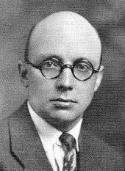
In October of 1926, the Pacific Broadcasting Corporation was formed as a subsidiary of the Seattle-based Northwest Radio Supply Company. Co-owners were Vincent I. Kraft of Seattle and Frederick C. Clift of San Francisco. In 1920, Mr. Kraft (photo, right) went on the air with a station that would become KJR, one of the first stations in Seattle. Also in October, the surplus equipment from defunct KFOB at Burlingame was acquired, with the expectation that this gear was to be used for the new San Francisco station.
Call letters KYA were reserved on November 30, 1926, for use by the Pacific Broadcasting Corporation, which scrapped the old KFOB equipment and purchased a new 500-watt transmitter. It was installed atop its proposed studio location, the Clift Hotel. On December 17, 1926, the Radio Division of the U.S. Department of Commerce’s Bureau of Navigation granted its authority for KYA to operate on 970 kilocycles with 500 watts of power. KYA went on the air Saturday, December 18, 1926, broadcasting from the Clift Hotel, San Francisco. Its license was received December 18th.
KYA was re-assigned to operate on 850 kilocycles with a power of 1,000 watts in November of 1927. By January of 1928, studios were moved from the Clift Hotel to the Warfield Theatre Building, 988 Market Street, and it then adopted the air slogan “West Coast Theatres Studio.” Its transmitter remained atop the Clift Hotel.
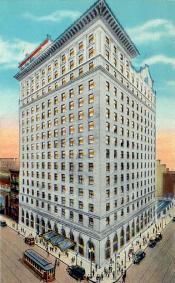
In the major frequency reallocations taking place November 11, 1928, which affected the dial position of most United States broadcast stations, KYA found itself reassigned to 1230 kilocycles. In late November 1928, the station joined the Columbia Broadcasting System as that chain’s San Francisco affiliate. Manager of KYA at this time was Clair E. Morrison.
By 1929, KYA’s air slogan was “The Theatre of The Air.” Its transmitter was reportedly located at 680 Geary (corner of Taylor Street), San Francisco, by May 1929.
On August 28, 1929, the Northwest Radio Service Company, parent of the Pacific Broadcasting Corporation, was declared insolvent and was then transferred to a court-appointed receiver. This financial stigma hit KYA’s licensee on September 13, 1929, as the Federal Radio Commission on that date granted an involuntary assignment of KYA’s license to F. O. Dahlquist, Receiver. In December 1929, the station was reportedly “silent” due to financial woes, but in late 1929 it was transferred to a new (solvent) Pacific Broadcasting Corporation.
After returning to the air, KYA changed its transmitting location to the Whitcomb Hotel, 1231 Market Street — a site vacated by San Francisco’s KFRC in May of 1927. This move was carried out on June 25, 1930. On that date, a new RCA 1001-B transmitter was placed into service. Studios remained at 988 Market Street, the Loew’s Warfield Theatre Building.
The 1930s
The National Broadcasting Company, under a new subsidiary, acquired the Pacific Broadcasting Corporation in late 1931. At this time, KYA switched from CBS to the NBC-Pacific Network, allowing for optional Red or Blue network programs. By June 1932, Edward McCallum was named Station Manager. In late 1932, offices of KYA were moved to NBC’s San Francisco studio complex located in the Hunter-Dulin Building at 111 Sutter Street, where KPO and KGO resided. Studios remained at 988 Market Street with KYA’s transmitter located atop the Whitcomb Hotel.
The Pacific Broadcasting Corporation was sold by NBC Inc. to William Randolph Hearst’s San Francisco Examiner newspaper in 1934. After this sale, KYA relocated to new office and studio quarters in the Examiner Building at Third and Market Streets, downtown San Francisco. Mr. McCallum elected to remain as KYA’s manager under the new ownership.
KYA’s licensee name was changed from the Pacific Broadcasting Corporation to Hearst Radio Inc. — no change in actual ownership — effective March 12, 1936. Authorization was granted by the Federal Communications Commission on July 17, 1936, for KYA to raise daytime power to 5,000 watts (nights to remain at 1,000 watts) and to change its transmitting location.
In late 1936, M. E. (Bob) Roberts replaced Edward McCallum as Station Manager. KYA’s secondary affiliation with NBC was dropped in 1936. On December 29, 1936, it became a charter member of the California Radio System, a loose-knit statewide network maintained mainly for sales purposes, but which occasionally interchanged programs. The chain was owned by the Hearst Radio and McClatchy Newspapers station groups. The key outlet was Hearst’s KEHE, Los Angeles. In April 1937, KYA opened an auxiliary studio in the Hotel Oakland, across the bay in Oakland.
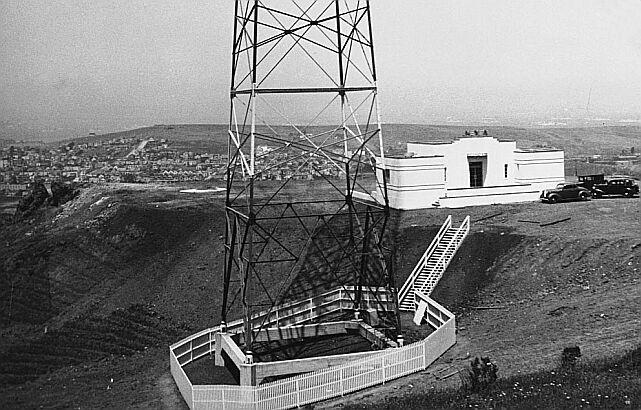
Daylight power of KYA was upped to 5,000 watts from a new RCA 5-C transmitter installed at Candlestick Point, near Bayview Park, at the southern edge of San Francisco, on May 15, 1937. A Bethlehem Steel vertical radiating antenna tower, measuring 450 feet in height, was erected on the west side of a hill, adjacent to KYA’s new one-story building atop Candlestick Hill (later known as “KYA Hill.”)
Bob Roberts was promoted to general manager at KYA in 1937. In January 1938, Clarence B. Juneau was named Station Manager and Commercial Manager of KYA. He transferred up from a similar position at Hearst’s KEHE Los Angeles (Mr. Juneau had founded that station in 1925).
By mid-1938, KYA was in operation from 6:30 a.m. until midnight daily (Sunday broadcast hours began at 8:00 a.m.) from studios in the Hearst Building at Third and Market Streets. J.V. Connolly was president of Hearst Radio Inc. at this time. On October 10, 1938, Reiland Quinn was named as KYA’s new general manager.
KYA closed its Hotel Oakland remote studio on November 1, 1938, with the notation that it “was too expensive to maintain.” By the end of 1938, a new Collins 20-H 250 watt transmitter was installed at “KYA Hill,” intended for backup service. The California Radio System was disbanded in 1939.
The 1940s
Harold H. Meyer was appointed as KYA’s general manager in 1940. Former manager Reiland Quinn remained with KYA for another year as its Program Director.
As a result of the NARBA Treaty frequency reallocations, taking place at 3:00 a. m. (EST), on Saturday, March 29, 1941, KYA was shifted from 1230 to 1260 kilocycles. An around-the-clock program schedule debuted on KYA by the beginning of 1942.
Hearst Radio Inc. sold KYA on June 24, 1942, to Palo Alto Radio Station, Inc., a group headed by Wilfred L. Davis. The organization was composed of 24 stockholders, which earlier was an unsuccessful applicant for a new AM broadcast station at nearby Palo Alto, Calif. The group then opted to purchase an existing station, with the intention of “identifying with the interests of Palo Alto residents,” paying $50,000 for KYA. Mr. Davis was president and 20 percent owner, and became general manager of the station after assuming control.
Don J. Fedderson, a vice president of Palo Alto Radio Station, Inc., became Commercial Manager of KYA in 1942, and was promoted to vice president and general manager in April 1943. Later in 1943, Mr. Fedderson succeeded Mr. Davis as president as well. Studios remained in leased space on the fifth floor of the Hearst Building in downtown San Francisco. The station’s stand-by Collins 20-H transmitter was sold to KWKW Pasadena in 1943.
KYA’s licensee, Palo Alto Radio Station Inc. was sold October 10, 1945, to New York Post publisher Dorothy Schiff Thackrey for $348,800. Mrs. Thackrey’s husband, Theodore O. Thackrey, was president and editor of the New York City newspaper. She named Bartley C. Crum to the post of KYA president in October 1945, with Don Fedderson continuing on as vice president and general manager. Studios of KYA were moved from the Hearst Building to new quarters in San Francisco’s Fairmont Hotel in July 1949.
The 1950s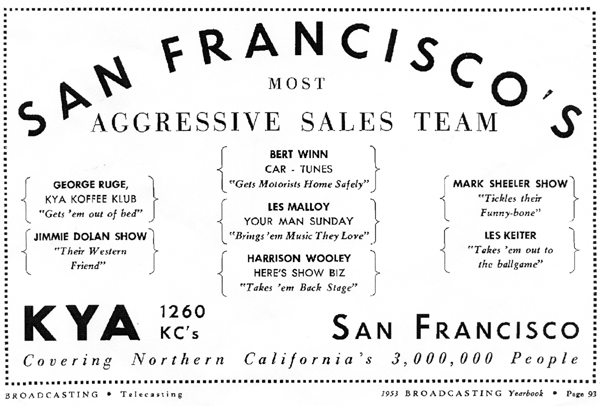
KYA’s licensee, Palo Alto Radio Station, Inc., was acquired from Dolly Thackrey by John Elroy McCaw and John D. Keating (each with 50 percent interest) for $155,000 on April 13, 1950; the pair also owned New York’s 1010/WINS. (McCaw’s son, Craig, would later found McCaw Cellular and XO Communications.)
J. G. Paltridge thereupon became general manager of KYA when the new owners took over, while Don Fedderson moved down the coast to manage Dorothy Schiff Thackrey’s AM and TV properties (KLAC and KLAC-TV) in Los Angeles. Also in 1950, KYA joined the Dallas-based Liberty Broadcasting System network as its Bay Area affiliate.
In 1951, the station’s licensee name was changed to the Palo Alto Broadcasting Company with H.G. Fearnhead installed as its new general manager. KYA’s licensee name was again changed — in 1952 — to Radio Station KYA, Inc. Effective May 16, 1952, the Liberty Broadcasting System ceased operations due to insolvency. At this time, KYA’s programming consisted of record shows presided over by disc jockeys.
In early 1954, KYA’s licensee name was simplified to KYA, Inc. Irving C. Phillips was appointed KYA’s new general manager in late 1956. The station was sold by the McCaw-Keating interests on May 1, 1958, to Golden State Broadcasters, Inc., for $1-million (the price included the permit for proposed KYA-FM). The FCC approved this transfer March 5, 1958. The firm was owned principally by Milwaukee broadcaster Gerald A. Bartell and his family. On May 1, 1958, Lee Bartell was named president and general manager of the station, which, on that date debuted a “Top 40” popular music format.
Studios were moved from its earlier quarters nearby in the Fairmont Hotel to One Nob Hill Circle in the summer of 1958. (KYA-FM, at 93.3 megacycles, went on the air in January 1959, duplicating KYA’s AM programming fulltime.)
In early 1959, Gerald Bartell became president of KYA’s licensee as Morton J. Wagner concurrently became vice president and general manager. Golden State Broadcasters, Inc., was transferred from Gerald A. Bartell, et al, to Bartell Broadcasters, Inc., on September 3, 1959. Lee Bartell became president and Gerald Bartell became vice president of KYA effective in late 1959.
The 1960s
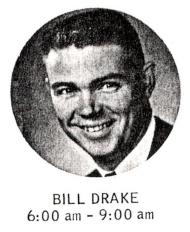
Jayne Swain, previously vice president and general manager of Bartell’s co-owned WAKE/Atlanta, was transferred to KYA in 1961 to serve in the same capacity.
Among Swain’s moves at KYA was to bring Bill Drake (nom de radieux of Phil Yarborough) in as program director and morning drive host in November 1961. Drake installed a new, fast-paced Top 40 format, dubbed “The Boss of the Bay” which he would shortly take to Knox LaRue’s KSTN/Stockton and Gene Chenault’s KYNO/Fresno with the launch of his own programming consultancy, which – in partnership with Chenault – would perfect the Top 40 “Boss Radio” format at stations across the country.
Les Crane (air name of Leslie Stein; BARHOF 2023) became KYA’s Program Director in January 1962. Bill Drake remained at KYA as morning man at least through the end of October 1962. Crane later moved to KGO as part of their foundational talk programming, then transitioned to television as host of an eponymous interview show on the ABC network (1964-1965), and also had a national Top Ten record with the spoken-word “Desiderata” (1971).
Veteran Buffalo, N.Y., broadcaster Clinton D. Churchill, through his Churchill Broadcasting Corporation, acquired KYA and KYA-FM for $1.25-million on Tuesday, August 7, 1962. Mr. Churchill then assumed the post of president and general manager of KYA. FCC approval took place July 25, 1962. New vice president of the station was Lewis H. Avery, who also served as KYA’s sales manager. By 1964, KYA operated 24 hours a day from studios located at Number One Nob Hill Circle, San Francisco.
KYA became the property of the Avco Broadcasting Corporation in August 1966. FCC approval of the $4.4-million sale took place August 24, 1966. The new licensee was a subsidiary of the Avco Corporation. KYA’s licensee name was changed to the Avco Broadcasting Corporation of California on September 28, 1966. Lewis H. Avery was named vice president and general manager in October 1966.
In February 1967, Howard S. Kester became KYA’s new general manager. Effective February 10, 1969, KYA’s licensee name was changed again — to the Avco Radio Corporation.
The 1970s
Former co-owner J. Elroy McCaw died at age 57 on August 17, 1979. From 1954 to 1962, he also owned WINS in New York City. Lewis Havens Avery, former KYA general manager, died November 25, 1971, at 69 years of age. Former Board Chairman Clinton H. Churchill died August 26, 1973. He was 85. His son, Clinton D. Churchill, owned KYA from 1962 until 1966.
Howard Zwick was named acting general manager by KYA’s management in August 1974 to replace the departing Howard Kester. In October 1974, Clifford M. Hunter was appointed general manager of the contemporary music-formatted station. A “Pop Adult Music” format was adopted in 1976.
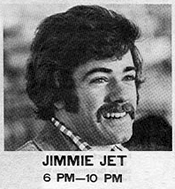
The Avco Radio Corporation sold KYA (plus KYA-FM and WRTH at Wood River, Illinois) to the King Radio Broadcasting Company, a subsidiary of the Seattle-based King Broadcasting Company, on October 20, 1977.
King Radio’s owners were Dorothy Bullitt and her daughters, Harriet B. Rice and Priscilla B. Collins, all Seattle residents. The $4-million transaction obtained FCC sanction on August 22, 1977. Ancil H. Payne was president of the buying organization and James D. Kime was transferred down from Seattle to become KYA’s new vice president and general manager.
By 1979, KYA simulcast KYA-FM’s automated programming from 2:00 a.m. until 6:00 a.m. In the fall of 1979, KYA moved studios from One Nob Hill Circle (behind the Mark Hopkins Hotel) to new modern facilities at 300 Broadway in San Francisco’s Financial District. Those quarters were dedicated in March 1980.
The 1980s
Jim Kime was promoted to VP-Radio for the King Radio Broadcasting in June 1980. Effective July 1, 1980, Fred Schumacher became KYA’s new general manager. By December 1980, the station featured a mass appeal Adult Contemporary music format, dubbed “Easy Rock 1260.” KYA adopted an Oldies music format in 1981. AM stereo broadcasts began in the summer of 1983, utilizing the Motorola C-QUAM system.
KYA was sold by the King Radio Broadcasting Company on December 13, 1983, to the Bay Area Broadcasting Company, a subsidiary of Bonneville International Corporation, for $3.5-million. King Broadcasting concurrently upgraded in the market by purchasing KSFO from Gene Autry’s Golden West Broadcasting. FCC approval of the KYA transfer took place October 19, 1983.
Arch L. Madsen was president of Bonneville, which was the broadcast division of the Corporation of the president of the Church of Jesus Christ of Latter-Day Saints. president of the Bay Area Broadcasting Company was Jack Adamson.
Call letters were changed from KYA to KOIT on December 13, 1983, when an Easy Listening music format debuted. Gone, along with the historic KYA calls, was its Golden Oldies music format. At this time, studios were moved from 300 Broadway to 77 Maiden Lane, and Kari Johnson Winston became vice president and general manager. KOIT then began 75 percent duplication of its new FM sister station, KOIT-FM (96.5).
A new “Trendformation” format, developed by program director Norm Woodruff — faced with a lean budget — debuted July 15, 1985. At this time, KOIT(AM) changed call letters to KXLR and switched to a news and information format, which featured Mutual Broadcasting System network and BBC World Service programs, plus Light Jazz and New Age music. Twenty minutes of music per hour were presented. The call-letter change received FCC authorization in mid-June.
When Kari Winston was transferred to a Bonneville-owned FM station in Los Angeles in early September 1985, Charles R. (Chuck) Tweedle assumed the post of vice president and general manager of KXLR and KOIT(FM). President Jack Adamson was reassigned to new duties at Bonneville-owned KSL Salt Lake City in early October 1985.
Call letters were changed back from KXLR to KOIT in mid-January 1986 and, by the end of the month, its unsuccessful “Trendformation” format was dropped with the AM station switching to a Light Rock Music format, simulcasting fully the FM program schedule. Its MBS network affiliation ended at this time.
Significant changes in technical facilities were taking place in early 1986. In the first move to erect a new transmitting tower to replace the aging self-supported 450-foot tower at Bayview Park, the original tower was toppled in early 1986 and KOIT(AM) switched to an 80-foot temporary antenna atop its transmitter building. (In April 1986, its old tower was lying on its side across the northwest face of the hill). The FCC granted KOIT permission on May 20, 1986, to construct a new tower on the same site. In 1987, the downed tower was removed by work crews and a new guyed antenna tower took its place. Also in 1987, AM stereo broadcasts ended.
KOIT switched to a Contemporary Music format, fully duplicating KOIT-FM, in 1989.
The 1990s
Former owner and president Gerald A. Bartell died at 76 at his Wisconsin home on July 27, 1990. In 1992, the KOIT stations moved to new modern offices and studios at 400 Second Street, Suite 300, San Francisco. (A year later, its old studios at 77 Maiden Lane were taken over by KDFC AM and FM). In 1998, KOIT relocated to new studios at 455 Market Street, Suite 2300, in San Francisco.
KOIT operated on 1260 kHz. with 5,000 watts by day and 1,000 watts by night, from studios at 455 Market Street, Suite 2300, San Francisco, Calif., with its transmitter and tower at Bayview Park, south of the city. The independent station was licensed to the Bonneville Holding Company. Charles R. (Chuck) Tweedle (BARHOF 2023) was vice president and general manager of what was then California’s 30th-oldest continuously licensed AM broadcast station, which duplicated KOIT-FM’s Adult Contemporary music format 24 hours a day.
RELATED EXHIBITS:




Is KYA off the air? I tune in to 1260 but its just a Catholic radio station, the website for KYA is still up though?
Unfortunately, KYA hasn’t been on 1260 in San Francisco since December 1983, as noted in the article above.
still great and on the air
I’ve been away from the Bay Area for more than 25 years, now. Just the same, a part of my childhood died with the loss of KYA and competitor, KFRC.
I worked for KYA-AM/FM when James Kim was the General Manager. I remember when he took the staff out to lunch after he transferred from King Broadcasting in Seattle. I remember distinctly when he was asked if he planned on making any staff changes. He said NO. He lied. On day he fired the entire programming dept including the DJ’s. We loved those people. Just saying the way it happened. Armando.